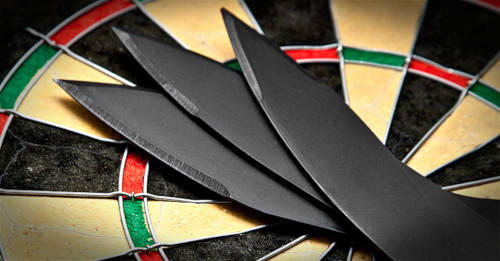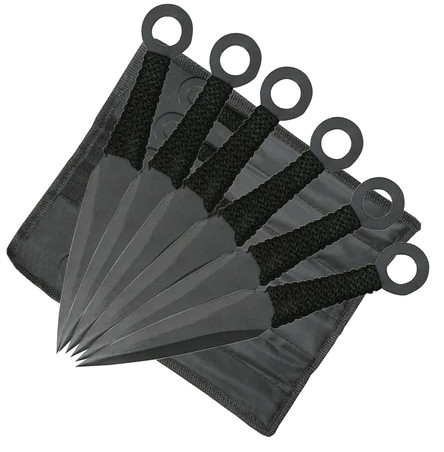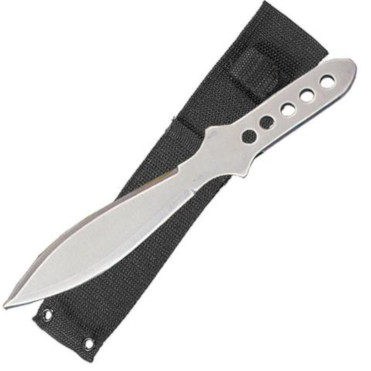Are Throwing Knives Effective?

Throwing knives can indeed be useful for self-defense. They come in various designs like blade-heavy, handle-heavy, and balanced types, each serving different throwing styles and providing options that fit individual techniques. However, while they may seem like an exciting idea inspired by action movies, their practical effectiveness highly depends on the skill and training of the user. This isn't like picking up a stick—it's more akin to learning to paint a masterpiece. Part of the equation involves understanding spin and no-spin methods.
Throwing knives can be effective for self-defense when used by individuals with proper training and expertise. However, it is essential to remember that laws and regulations regarding carrying and using such items vary by location, so thorough research and understanding of legal implications are crucial before considering them for self-defense purposes.

Varieties of Throwing Knives
When it comes to throwing knives, you'll find a variety of designs suited to different needs. The three main types are blade-heavy, handle-heavy, and balanced knives. Each type has its own unique features that provide distinct advantages for throwing purposes. Let's take a closer look at what sets them apart from one another.
Blade-Heavy Knives
Blade-heavy knives, as the name suggests, have a heavier blade compared to the handle. This design allows for a faster spin when thrown. The weight distribution enables these types of knives to rotate swiftly in the air, making it an ideal choice for long-distance throwing. Additionally, the increased rotational speed can result in deeper penetration upon hitting the target. It's important to note that while the fast spin benefits long-range throws, it may not offer the same level of accuracy as certain other designs.
Blade-Heavy Knife Features:
- Weightier blade compared to the handle
- Enables faster spinning and deeper penetration
- Ideal for long-distance throws but may compromise on precision
 BioHazard Throwing Knives
BioHazard Throwing Knives
Handle-Heavy Knives
Handle-heavy knives are characterized by a heavier handle relative to the blade. This configuration provides enhanced control and stability during throwing motions. By distributing more weight towards the handle, these knives offer improved accuracy and consistency in short to medium-distance throws. The balanced weight distribution allows for a smooth release and controlled flight path.
Handle-Heavy Knife Features:
- Heavier handle in relation to the blade
- Offers enhanced control and stability
- Ideal for short to medium-distance throws with improved accuracy
Balanced Knives
Balanced knives strike a middle ground between blade-heavy and handle-heavy designs. They are engineered with an equal distribution of weight between the blade and the handle, resulting in a neutral balance. This equilibrium makes balanced knives versatile, catering to a wide range of throwing styles and techniques. They offer a blend of speed and precision, making them suitable for both short and long-range throwing.
Balanced Knife Features:
- Equally distributed weight between the blade and handle
- Versatile design suitable for various throwing styles
- Offers a balance of speed and precision for both short and long-range throws
Understanding these differences allows throwers to make informed decisions based on their specific preferences and intended use. Whether prioritizing speed over control or seeking a middle ground between the two, there's a throwing knife design tailored to individual techniques and needs.
Methods in Throwing: Spin and No-Spin
When it comes to throwing knives effectively, the method you use can significantly impact your accuracy and distance. Let's explore the two primary methods: Spin and No-Spin, each with distinct advantages and best-suited scenarios.
Spin Technique
The spin technique involves holding the knife by the handle and making it rotate several times along its longitudinal axis before hitting the target. As the knife spins, this movement provides stability and accuracy, making it ideal for longer distances. When you release the knife using a spin technique, the multiple rotations help stabilize its flight path, compensating for any environmental factors like wind resistance over a longer period. This method requires precision and timing, as getting the right number of rotations is crucial to accurately reach your target.
This technique is popular among enthusiasts who participate in long-distance knife throwing or competitions due to its ability to effectively cover greater distances with improved accuracy. It offers an added advantage when targeting objects at a significant range. Mastery of this method involves understanding the speed and force required to generate the desired number of rotations for different distances.
Quick Tip: Consistent hand placement and rotation control are key for successful knife throws using the spin technique. Practice is essential to develop muscle memory for releasing the knife at just the right moment to achieve optimal rotation prior to striking your intended target.
No-Spin Technique
In contrast, the no-spin technique focuses on throwing the knife without rotation, with the point of the knife leading the throw. This straightforward approach is best suited for shorter distances where precision is crucial. The lack of rotation allows for a direct and swift trajectory toward the target, minimizing room for error and enabling accurate and efficient strikes at close range.
Knife enthusiasts find the no-spin technique especially beneficial for self-defense scenarios due to its quick and precise delivery at short distances, making it suitable for tactical situations that require immediate action.
It's important to note: Mastering both techniques can provide valuable skills for varying situations, enabling an individual to adapt their throwing style based on distance, target size, and environmental conditions.
The spin and no-spin techniques offer unique advantages tailored to specific throwing requirements, showcasing the versatility of skilled knife throwing as both an art form and a practical self-defense skill.
Defining Optimal Distance for Throwing

Throwing knives effectively depends on finding the right balance between distance, the type of knife being used, and individual skill level. When determining the optimal throwing distance, several factors need to be considered.
The type of knife you're using plays a significant role in deciding the optimal throwing distance. For example, blade-heavy knives tend to perform better at longer distances due to their aerodynamic qualities, while handle-heavy knives may be more effective at shorter ranges. Understanding these features is crucial in aligning your throwing technique with the specific characteristics of the knife you're using.
Moreover, your skill level also dictates the ideal distance for throwing. Novices may find it easier to start practicing at shorter distances and gradually extend as they enhance their proficiency. It's a process of gradual improvement that requires patience and practice to master.
Consider it similar to learning how to ride a bicycle - starting off with small, steady movements before confidently venturing further. Similarly, mastering the art of throwing knives involves starting from a comfortable distance where accuracy and consistency can be achieved before gradually challenging oneself with longer ranges.
As with any skill, practice is key. By consistently practicing at various distances, individuals can develop an understanding of how different variables, such as strength and technique, come into play at different ranges. This comprehensive practice approach fosters adaptability and precision across varied situations and distances.
Understanding the optimal distance for throwing knives is a multi-faceted endeavor that involves consideration of individual skill level, knife dynamics, and consistent practice at varying ranges to achieve proficiency and accuracy.
Enhancing Precision for Self Defense
When using throwing knives for self-defense, precision is paramount. Consistent practice is vital to acquaint yourself with the weight distribution of your knives and develop muscle memory. The more you practice, the better you'll comprehend how the knife moves through the air and how much force to exert when throwing. Understanding weight and motion is critical for accurate target hits, especially under pressure.
Another method to enhance precision is by simulating real-world scenarios during practice. This involves designated targets and obstacles to replicate the unpredictability of an actual self-defense situation. Adapting to different distances, angles, and obstacles during practice will prepare you for potential challenges in a real-life encounter.
For instance, creating a simulated course in your backyard with targets at varying distances and heights behind obstacles like trees or rocks can hone your precision and ability to adjust your throw for different scenarios.
Furthermore, environmental factors such as wind and lighting significantly impact precision. Wind can alter the knife's trajectory, so learning to gauge and compensate for wind speed and direction is crucial. Similarly, factoring in how lighting conditions affect visibility and aiming is essential. Training in different lighting conditions equips you to adapt to variable visibility scenarios, ensuring accuracy regardless of environmental factors.
Additionally, training in various positions and stances is important. Practicing from different postures helps develop the flexibility required to execute accurate throws from any position, which can be crucial during a defensive encounter.
Perfect Point Throwing Knife Set
By consistently practicing on designated courses that replicate real-world challenges and factoring in environmental elements like wind and lighting into your training regimen, you can significantly enhance your precision when using throwing knives for self-defense.
Advancing beyond the discussion of precision in using throwing knives for self-defense, let's now explore the effectiveness and limitations of these tools in real-life defensive scenarios.
Effectiveness and Limitations of Throwing Knives
Throwing knives are undeniably intriguing and are often depicted in movies as a cool and effective weapon. However, they have both strengths and limitations when it comes to real-life self-defense.
Effectiveness: When used by a skilled individual with appropriate training, throwing knives can provide a crucial advantage in certain scenarios. They offer the ability to engage from a distance and can create a valuable distraction. In skilled hands, they can be accurate and effective at subduing an attacker or creating an opportunity to escape from danger. Their use as a supplementary tool alongside other forms of self-defense should not be underestimated.
However, effective use of throwing knives requires a significant amount of practice and proficiency. It is not a skill that can be effectively wielded without consistent and dedicated training.
Imagine practicing the same throw over and over, never hitting the target. This persistence might seem daunting at first, but with time and effort, each throw gets closer and more accurate until you're hitting the bullseye every time. This level of precision is essential when using throwing knives for self-defense.
Limitations: While throwing knives present certain advantages, understanding their limitations is equally important. The foremost drawback is their limited range in comparison to firearms or other long-range defensive tools. This means that in a typical self-defense situation, the user would need to be relatively close to the threat in order to effectively deploy the throwing knife.
Another significant limitation is the need for retrieval after each throw. Unlike a firearm, where multiple shots can be fired rapidly, or pepper spray, where multiple bursts are possible, throwing knives require accurate aim and immediate retrieval to be ready for subsequent use.
It’s also important to note that if thrown improperly, knives may not penetrate deeply enough or inflict enough damage to neutralize the threat. This could potentially enrage an assailant rather than subdue them, escalating the level of danger in a confrontation.
If one decides to carry throwing knives for self-defense, they must always remember that having them without proper training doesn’t guarantee safety. This is akin to carrying a parachute without ever knowing how to open it when jumping out of an airplane.
In the end, while throwing knives can serve as an additional layer of defense in specific situations, understanding their strengths and limitations is critical in assessing their overall utility for personal protection.
Safety Considerations in Throwing Knives
When it comes to practicing with throwing knives, safety should always be the top priority. Think of it this way, the importance of safety measures is akin to wearing a seatbelt when driving—it's a non-negotiable aspect of responsible ownership. One major rule is ensuring you have a clear, safe range before even thinking about practicing your throwing technique. This means being aware of your surroundings and understanding where your knife will go if you miss your target. Just like learning to dance, you should never practice in a crowded space where someone could accidentally walk into your path.
Furthermore, practicing with appropriate protective gear is a smart move. Gloves not only protect your hands from cuts and scrapes but also improve your grip. Eye protection—like protective goggles—shields your eyes from any debris that may kick up during practice. It's a bit like wearing a helmet while cycling; even if you're confident in your skills, it's best to be prepared for unexpected mishaps.
Remember, mishaps happen—maybe not today or tomorrow, but there's always a chance—so it's better to be prepared and prevent accidents from happening.
In addition to prioritizing personal safety, it's equally crucial to adhere to local laws and regulations regarding the use of throwing knives. Every town and city can have different rules about owning and using these weapons, and remaining compliant with them is not just good practice; it's the law.
So, let’s wrap up—just like being responsible behind the wheel makes you a better driver, being responsible with these potentially dangerous tools makes you a more skilled practitioner.
Similarly, just as seatbelts are non-negotiable for ensuring road safety, practicing safety measures when using throwing knives is essential for protecting yourself and others around you.
Incorporating these safety considerations into your practice routine will not only protect you from potential harm but also cultivate a respectful and responsible approach to using throwing knives.
By taking these precautions seriously, the art of knife throwing can be an exciting skill that is enjoyed responsibly and safely. Happy practicing!
Add your comment now!
Post Comment


